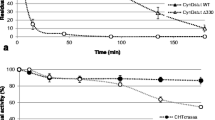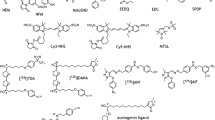Abstract
Differential chemical modification ofE. coli chaperonin 60 (cpn60) was achieved by using one of several sulfhydryl-directed reagents. For native cpn60, the three cysteines were accessible for reaction with N-ethylmaleimide (NEM), while only two of them are accessible to the larger reagent 4,4′-dipyridyl disulfide (4-PDS). However, no sulfhydryl groups were modified when the even larger reagents 5,5′-dithiobis-(2-nitrobenzoic acid) (DTNB) or 2-(4′-(iodoacetamido)anilino) naphthalene-6-sulfonic acid (IAANS), were employed, unless the chaperonin was unfolded. The cpn60 that had been covalently modified with NEM or IAANS, was not able to support the chaperonin-assisted refolding of the mitochondrial enzyme rhodanese, which also requires cpn10 and ATP hydrolysis. However, both modified forms of cpn60 were able to form binary complexes with rhodanese, as demonstrated by their ability to arrest the spontaneous refolding of the enzyme. That is, chemical modification with these sulfhydryl-directed reagents produced a species that was not prevented from interaction with partially folded rhodanese, but that was prevented from supporting a subsequent step(s) during the chaperonin-assisted refolding process.
Similar content being viewed by others
References
Badcoe, I. G., Smith, C. J., Wood, S., Halsall, D. J., Holbrook, J. J., Lund, P., and Clarke, A. R. (1991).Biochemistry 30, 9195–9200.
Buchner, J., Schmidt, M., Fuchs, M., Jaenicke, R., Rudolphe, R., Schmid, F. X., and Keifharber, T. (1991).Biochemistry 30, 1586–1591.
Georgopoulos, C., and Ang, D. (1990).Sem. Cell Biol. 1, 19–25.
Gething, M. J., and Sambrook, J. (1992).Nature 355, 33–45.
Goloubinoff, P., Christeller, J. T., Gatenby, A. A., and Lorimer, G. H. (1989a).Nature 342, 884–889.
Goloubinoff, P., Gatenby, A. A., and Lorimer, G. H. (1989b).Nature 337, 44–47.
Haugland, R. P. (1975).J. Supramol. Str. 3, 338–347.
Hemmingsen, S. M., Woolford, C., van der Vies, S. M., Tilly, K., Dennis, D. T., Georgopoulos, C. P., Hendrix, R. W., and Ellis, R. J. (1988).Nature 333, 330–334.
Horowitz, P. M. (1978).Annal. Biochem. 86, 751–753.
Laminet, A. A., Ziegelhoffer, T., Georgopoulos, C., and Plückthun, A. (1990).EMBO J. 9, 2315–2319.
Lissin, N. M., Venyaminov, S. Y., and Girshovich, A. S. (1990).Nature 348, 339–342.
Martin, J., Langer, T., Boteva, R., Schramel, A., Horwich, A. L., and Hartl, F.-U. (1991).Nature 352, 36–42.
Mendoza, J. A., Rogers, E., Lorimer, G. H., and Horowitz, P. M. (1991a).J. Biol. Chem. 266, 13,044–13,049.
Mendoza, J. A., Rogers, E., Lorimer, G. H., and Horowitz, P. M. (1991b).J. Biol. Chem. 266, 13,587–13,591.
Mendoza, J. A., Lorimer, G. H., and Horowitz, P. M. (1991c).J. Biol. Chem. 266, 16,973–16,976.
Miller, D. M., Delggado, R., Chirgwin, J. M., Hardies, S. C., and Horowitz, P. M. (1991).J. Biol. Chem. 26, 4686–4691.
Sörbo, B. H. (1953).Acta Chem. Scand. 7, 1129–1136.
Tandon, S., and Horowitz, P. M. (1986).J. Biol. Chem. 261, 15,615–15,618.
Viitanen, P. V., Lubben, T. H., Reed, J., Goloubinoff, P., O'Keefe, D. P., and Lorimer, G. H. (1990).Biochemistry 29, 5665–5671.
Wang, S.-F., and Volini, M. (1973).J. Biol. Chem. 248, 7376–7385.
Westley, J. (1973).Adv. Enzymol. Rel. Areas Mol. Biol. 39, 327–368.
Author information
Authors and Affiliations
Rights and permissions
About this article
Cite this article
Mendoza, J.A., Horowitz, P.M. Sulfhydryl modification ofE. coli cpn60 leads to loss of its ability to support refolding of rhodanese but not to form a binary complex. J Protein Chem 11, 589–594 (1992). https://doi.org/10.1007/BF01024958
Received:
Published:
Issue Date:
DOI: https://doi.org/10.1007/BF01024958




